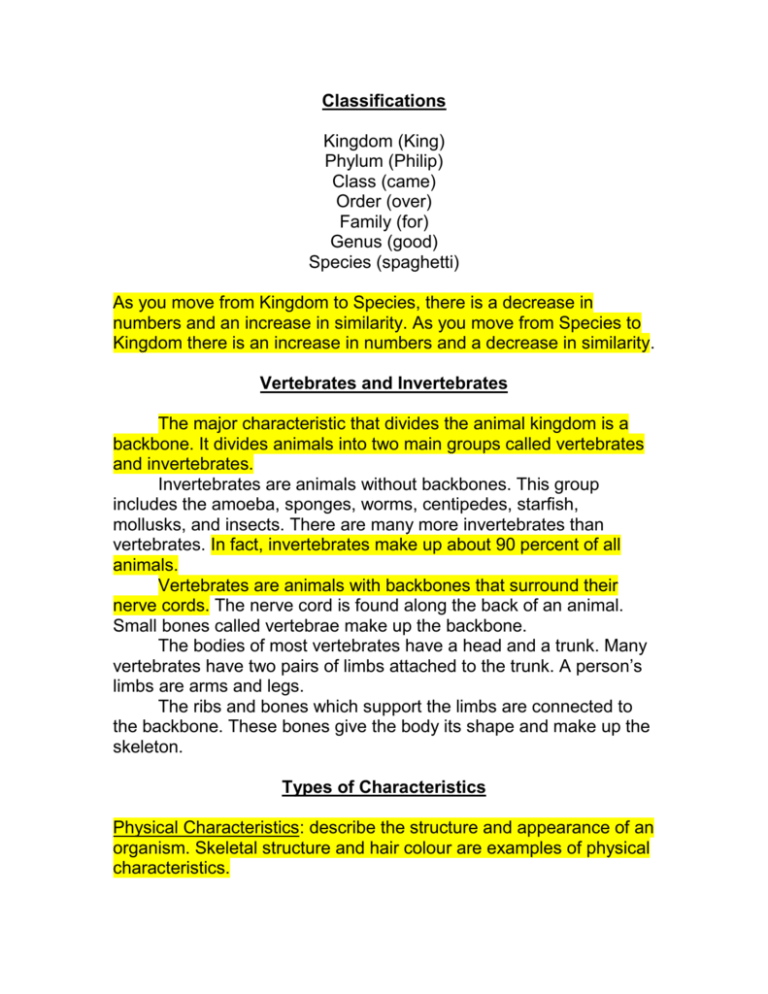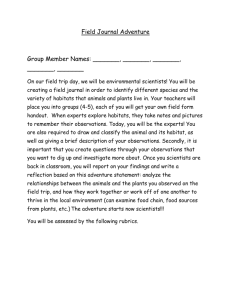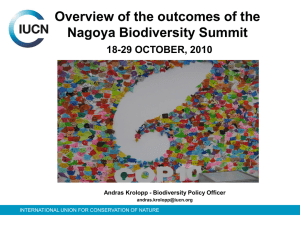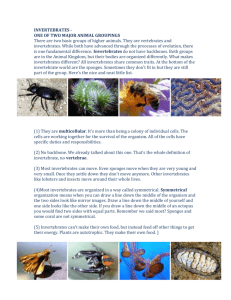Biodiversity
advertisement

Classifications Kingdom (King) Phylum (Philip) Class (came) Order (over) Family (for) Genus (good) Species (spaghetti) As you move from Kingdom to Species, there is a decrease in numbers and an increase in similarity. As you move from Species to Kingdom there is an increase in numbers and a decrease in similarity. Vertebrates and Invertebrates The major characteristic that divides the animal kingdom is a backbone. It divides animals into two main groups called vertebrates and invertebrates. Invertebrates are animals without backbones. This group includes the amoeba, sponges, worms, centipedes, starfish, mollusks, and insects. There are many more invertebrates than vertebrates. In fact, invertebrates make up about 90 percent of all animals. Vertebrates are animals with backbones that surround their nerve cords. The nerve cord is found along the back of an animal. Small bones called vertebrae make up the backbone. The bodies of most vertebrates have a head and a trunk. Many vertebrates have two pairs of limbs attached to the trunk. A person’s limbs are arms and legs. The ribs and bones which support the limbs are connected to the backbone. These bones give the body its shape and make up the skeleton. Types of Characteristics Physical Characteristics: describe the structure and appearance of an organism. Skeletal structure and hair colour are examples of physical characteristics. Behavioral Characteristics: describe the organism’s actions. Movement and feeding habits are behavioral. Behaviour may be learned or instinctual. Static Characteristics: remain the same over time. Fingerprints and DNA samples are static characteristics used to identify people. Dynamic Characteristics: change over time as an organism ages or as situations change. Some physical characteristics (hair colour, size) and behavioural characteristics are dynamic. Adaptation Some adaptations are physical or structural. These adaptations allow animals to survive in their environment by allowing them to survive the climate, find food and shelter and defend themselves against predators. Some adaptations are behavioral. These are activities that animals do to help them survive. These behaviors are either taught to them by their parents or they are born with them (instinct). For example, how an animal behaves when threatened or scared is a behavioral adaptation. Some animals have adapted mimicry, which means they can sound, look or act like other animals. Biodiversity Biodiversity is the variety of life on earth. Biodiversity includes the diversity of individuals, species and ecosystems (a system that consists of living organisms and their environment which interact together). Biodiversity is important to the health of our planet. Biodiversity includes variety within each species of plant and animal. Biodiversity within species is important for maintaining that species. For example, because of genetic differences, not all squirrels are affected equally by infectious diseases. Biodiversity is also important within and among communities. For example, having a variety of species of wheat allows for some part of the crop to survive adverse (poor weather) conditions. Benefits and Consequences of Biodiversity Human societies benefit greatly as a result of biodiversity. Thousands of products such as food, clothing, medicine and building materials come from plants and animals. Everyday products come from a diversity of organisms (pain relievers are derived from the bark of the white willow tree; tofu is made from soybeans; silk is made from silkworm cocoons; shampoos, toothpastes, and deodorants contain pollen collected by bees. Imagine that a local forest is slated to be cut down to make room for a new shopping plaza. A positive aspect is that a community will have access to goods and services in the new shopping plaza that were not there before, however, a negative aspect is that getting the land for the shopping plaza means losing a local forest. As a result, the perspectives of the developer of the shopping plaza, people concerned about the environment, and residents of the local community might be similar or different. In order to make others aware of an issue like the new shopping plaza, we could write a letter or send an email to the local newspaper, the mayor, or our Member of Parliament.











